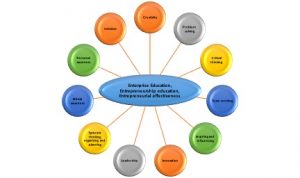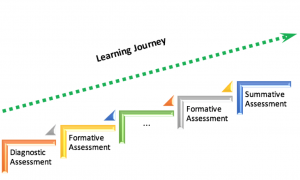RIP Prof. Sir Ken Robinson
Very sad news I received last week when I was on holiday in Poland that Prof. Sir Ken Robinson dies peacefully after a short fight with cancer on 21 August 2020. Sir Ken has been a great inspiration for me as an academic and great role model. His speeches and books have triggered plenty of new ideas in my mind. His seminal speech on creativity, Do Schools kill creativity? has more than 65 million views. It is a great speech and to me is a thought-provoking speech which I have watched more than 20 times. His speech on Wisdom was also one of his best.

Strategies to improve students’ engagement
My interactive workshop in HEA STEM Conference 2018
My presentation on How to design the activities in a flipped classroom
How to Flip a Mathematics Classroom – An Example
In this post I present a journey from GCSE to advanced mathematics using Sierpinski Gasket! The activity can also be done similarly by using the Cantor set for those higher level mathematics modules.
Flipping a Mathematics Classroom – Part 1
My presentation on Flip Model for FBL academic staff
Click on the link below – which will take you to my presentation (I use Adobe Spark):
Flip Model – What, Why, & How? [contact-form][contact-field label=’Name’ type=’name’ required=’1’/][contact-field label=’Email’ type=’email’ required=’1’/][contact-field label=’Website’ type=’url’/][contact-field label=’Comment’ type=’textarea’ required=’1’/][/contact-form]
Wold you like to create FORMS online?
WUFOO will do it for you. Look at my first test form:
Creativity & Enterprise
“The most important stage of any enterprise is the beginning.” Plato
Creativity
It is not easy to define creativity. It is related to a plenty of our thoughts, actions, and activities. Overall, it can be defined as the ability of generating/recognizing new and imaginative ideas, connecting them with others to reveal/create some hidden patterns or anomalies and turning them into reality or using them in a problem solving situation. The following diagram shows the concepts and skills which were used to put the above definition together:
The ability of thinking outside the box and seeing things from different perspective, being flexible and adaptable in an uncertain situation, being inquisitive and asking effective questions, the ability to work with others as well as working independently, maintain motivated and ambitious, … all and all are the main characteristics of creativity and being creative.
When it comes to teaching and learning all these aspects are going to be considered from teaching & learning perspective to provide an educational environment in which not only educators perform creatively but also their delivery could create the environment in which students could develop their creativity skills and also being creative in their daily life practice as a student and more importantly as a citizen of the global world.
Enterprise
21st century needs, created a very competitive situation for graduate to secure good job roles. This also has a great impact on universities teaching & learning methods and materials to provide students and graduates not with just their academic degree but with the tools, skills and knowledge that they could live, participate, and contribute as global citizens. For this reason, throughout design of our education strategy some large and small businesses representatives were consulted and given the chance to comment on independent learning and employability skills and issues. Their suggested that “universities have a role that is much more than that teaching the academic content to enable a student to become a graduate.” (CU Education strategy, p.39) The academic degree and certain level of knowledge is a must for graduate “but they also need to know how to think”, “motivated and self-driven” (ibid., p.40) Students need to be given the opportunity to do things for themselves rather than receiving everything done for them. This will encourage them to think outside the box and enable them to deal with new scenarios in their job interviews or any sort of problem-solving activities.
Their comments support University approach to enterprise, innovation and creativity and the CU contribution “to the economic prosperity and knowledge society of Coventry and Warwickshire, the UK and the international economy.” (Creating Better Futures, Corporate Strategy, p.17)
Spectrum of Assessments – Learning Journey
“Assessment is not an end point of learning, but part of the learning process.” Coventry University Assessment Strategy 2015-2021
Assessment as Learning/Formative Activities (FA)
Definition & purposes:
Assessment as learning drives learning. One of the main purposes of the assessment as learning is to provide the educators the opportunity to design strategies & relevant tactics towards more personalised learning materials for students. This will empower students to take more active part in their learning experience.
Educators are making professional judgements on the students’ performance all the time in their teaching & learning practice. This might be a conscious or unconscious judgement. In either case, translating the professional judgements into quality feedback is a big challenge for the educators in their teaching and learning practice. One of the main focuses of FA is providing educators with strategies to translate their professional judgments into effective feedback and feedforward on students’ performance and work. This is a progressive continual procedure.
The quality and effectiveness of feedback is of vital importance in FA. This will in turn, provides both educators and students with the opportunity of designing targeted feedforward tactics to assist students on their progress. In doing so, students not only will be receiving continual and progressive structured feedback but also by receiving the it exactly at the time they need it during doing the formative task. FA empower students to continue and finish the task at hand by using both the feedback to reflect on their performance and works and also the feedforward tactics to move further steps forward and possibly complete the task.
A suggestive model for implementing FA:
Educators should think and design specific strategy which is a long-term plan to identify clear and transparent goals showing what students are going to achieve by the end of the session/module/course. This needs to be followed by a set of tactics which are the shorter term plans which are going to be designed to show how students are going to develop their learning experience and performance to reach their full potential. These tactics must be designed in a very flexible approach before and during the session.
The table below shows a model of assigning strategies to ILOs (intended learning outcomes) and then some initial tactics. These tactics have to be designed in a very flexible style in order to provide students with the best formative feedback as well as feed forward. They can be modified during the session in accordance to students’ performance and work in doing the formative activities (either individually or in small groups).
Whatever the contextual practice, the rational for this is always the same: increasing students’ attainment; creating the best opportunity for feedback for and from students to identify areas they need to improve and how best they can do it; increasing students’ engagement; providing educators with the opportunity of linking their lesson planning and students learning process.
Activities as Assessment:
FA has a vital role in practicing this model. Considering the classroom activities as part of the assessment is fundamentally crucial in learning process. Assessment as learning is the most appropriate means to show students the aim of the learning, to explain them why do they need to learn what they are learning, to enable them how far are they to achieve to the aims of learning, and finally and more importantly, telling them how they achieve those aims. When students have clear answer on those areas they could have a better, more effective and joyful learning journey. Sharing this information with students promotes their confidence in their learning journey which in turn, provide them the opportunity of reflecting on their work and self-assess their performance and consequently improve their motivation.
Main phases of FA:
Assessment as learning has two crucial phases:
- Designing the task(s)/activity(ies)
- Implementing the task(s)/activity(ies)
Design phase focuses on activities which can be done individually or in group by students with the goal of assisting and providing them the environment in which they could engage with the topic. These activities have to be designed in a way to be relevant and fill the gap between the old (what student know) and the new knowledge (what student is going to learn). A successful design has always included elements from both old and new knowledges. This will provide the opportunity of building links and bridge between what they already know and what they are learning. This is the most challenging part of the design phase.
The next crucial phase of FA is to implement the task(s). There are many important factors are involved to assist educators successfully implement the task/activity to formatively assess students’ progress. Some can be listed as, curriculum content (which part of the content which is being taught needs to be accompanied by an activity), time (at what stage of delivering the topic the activity should be given to the students), Kind (video, group work, mixed, etc.), length (how long the activity is going to be and why?) and so on.
In any case, throughout implementing these activities educators have the chance to reflect upon their teaching & learning tactics by observing students’ performance in accordance the instructions. More importantly, educators have the chance of providing students with information about how they were doing what they were doing and giving them insights and perspectives about what actions they need to take to improve their performance and develop their knowledge. Providing right and constructive information will assist them to reflect on their learning and promote their knowledge all through their learning journey. To have a successful implementation phase, educators needs to be prepared with good skills of providing effective feedback to students.
Diagnostic Assessment – DA
Definition & purposes:
This is a special form of formative assessment which is going to be taken place at the beginning of the learning journey. The main purpose of this type of assessment is to enhance and improve students’ performance and experience. Diagnostic assessment is a key factor in the path towards improving students’ performance to achieve intended learning outcome(s) based on their prior knowledge. The following diagram shows where exactly this type of assessment fit in students’ learning path.
As it shown above the main focus of this type of assessment is on what students’ prior knowledge related to intended learning outcome(s) of the lecture/module/course. Lack of understanding of students’ prior knowledge limits their engagement in their learning journey towards new knowledge. This type of assessment reveals strengths, weaknesses, skills and knowledge of the learners. Diagnostic assessment will assist educators to:
- Design and plan their teaching materials based on what students know/don’t know with regards to the intended learning outcome(s). This enables students to build the link(s) between the old and the new knowledges. This in turn, increases their engagement.
- Design and develop curriculum aligned with students’ prior knowledge related to the intended learning outcomes of the module/course.
- Reflect upon specific strategies, instructions and tactics in their teaching & learning practice.
Suggestion for implementing DA:
- In order to have an accurate and consistent result it is suggested to have a number of diagnostic assessments and use the average results.
- It has to be designed to assess learners’ old knowledge and skills at the beginning of their journey to the new
“There is a need for summative assessment points, however these must be seen as ongoing and not episodic, providing iterative loops of learning.” Coventry University Assessment Strategy 2015-2021
Assessment of Learning (Summative Assessment)
Definition & purposes:
This type of assessment indicates whether a learner achieved the intended learning outcomes. Summative assessment is the final stages in learner’s learning journey and indicates whether the intended learning outcomes the unit/module/course are achieved. Summative assessments evaluate students’ learning and skill acquisitions. It is more traditional style of assessing students’ performance and generally taken by the students at the end of unit/term/course.
The summative assessment, is where learners demonstrate the knowledge and skill. As it shown in the below figure summative assessment is the final judgment on students’ achievement and also effectiveness of teaching & learning strategies and tactics throughout a series of developmental and progressive formative assessments.
Summative vs. Formative
Table below shows some of the main differences between these two types of assessments:
|
Formative |
Summative |
| Check students’ understanding for further instructions | Provides information about attainment |
| Educators to reflect on their teaching & learning tactics | Results in grades which may use for students’ promotion |
| Providing effective feedback/feed forward for students while they are working | Measures level of success and proficiency of students at the end of unit/term/module/course by comparing it against some benchmark |
| Examples: Classroom tests/quizzes, Asking questions, Early course/module evaluation | Examples: Mid-term test, Final project, A paper |
Despite the differences, formative and summative assessments should be aligned with the intended learning outcomes. The spectrum of assessments below shows how these three types of assessments are connected and have to be designed aligned cohesively throughout students’ learning journey. The spectrum begins with the diagnostic assessment followed by a series of formative assessments and finally summative assessment.
Integrated Assessment
Definition & purposes:
This is where the focus of the assessment alters from modules to the course of study. Assessment strategy 2015-21 emphasises on the University commitment to a course-based approach towards assessment. One of the ten principles of the Coventry University assessment strategy says “Every course will include one or more integrative assessment points”.
Integrated assessment is the course level assessment and is designed aligned with the course learning outcomes rather than the learning outcomes of every single module of the course. This could happen in one or more stages throughout the course.
Design and Implementing Integrated Assessment:
IA has two main components:
- Clear understanding of the course leader on aligning the course and its modules learning outcomes
- Communications channel between the course leaders, Module leaders and course team
Example:
An example of an integrated assessment can be a portfolio or a project with a number of small sub-projects related to every single learning outcomes of the course.
[contact-form][contact-field label=’Name’ type=’name’ required=’1’/][contact-field label=’Email’ type=’email’ required=’1’/][contact-field label=’Website’ type=’url’/][contact-field label=’Comment’ type=’textarea’ required=’1’/][/contact-form]

 [contact-form][contact-field label=’Name’ type=’name’ required=’1’/][contact-field label=’Email’ type=’email’ required=’1’/][contact-field label=’Website’ type=’url’/][contact-field label=’Comment’ type=’textarea’ required=’1’/][/contact-form]
[contact-form][contact-field label=’Name’ type=’name’ required=’1’/][contact-field label=’Email’ type=’email’ required=’1’/][contact-field label=’Website’ type=’url’/][contact-field label=’Comment’ type=’textarea’ required=’1’/][/contact-form] 
